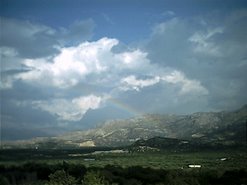Atsumori, Θέατρο Νο, όλο στο youtube
here is the summary
After killing the exceptionally young warrior, Taira no Atsumori, in the battle at Ichi-no-tani, Kumagai no Jirō Naozane, a warrior of the Genji clan, renounced the world and took the priestly name Rensei (Renshō), as he was overwhelmed by the tragedy and realized the uncertainty of life. When Rensei (Renshō) visits the Ichi-no-tani battlefield to pray for the repose of Atsumori's soul and looks back on the day, grass cutters appear, to the music of a flute. When Rensei (Renshō) speaks to them, one of them tells him the story associated with the flute.
here is the summary
After killing the exceptionally young warrior, Taira no Atsumori, in the battle at Ichi-no-tani, Kumagai no Jirō Naozane, a warrior of the Genji clan, renounced the world and took the priestly name Rensei (Renshō), as he was overwhelmed by the tragedy and realized the uncertainty of life. When Rensei (Renshō) visits the Ichi-no-tani battlefield to pray for the repose of Atsumori's soul and looks back on the day, grass cutters appear, to the music of a flute. When Rensei (Renshō) speaks to them, one of them tells him the story associated with the flute.
To the suspicious Rensei (Renshō), the man responds
that he has a connection with Atsumori and asks Rensei (Renshō) to
repeat the prayer to Amitabha Buddha ten times for the sake of Atsumori.
When Rensei (Renshō) recites the sutra connected with Amitabha
Tathagata, the man implies that he is the ghost of Atsumori and
disappears.
In the night, the ghost of Atsumori, who looks as he
was on his last day, appears before Rensei (Renshō), who prays for the
peace of Atumori's soul. Atsumori is delighted as Rensei (Renshō), who
prays for salvation through mourning Atsumori, was a foe but is a true
friend now. Atsumori then starts to confess. First, in the kuse
he describes the Heike clan's escape from Kyoto in the autumn of 1183,
their forlorn lives in Suma Bay, and the decline of the entire clan. He
then dances while recalling the party in the Ichi-no-tani camp in the
last night of his life. He shows the past battle scene in which Atsumori
came to the beach at Ichi-no-tani to embark on a boat, but Kumagai
called after him to challenge him to single combat. Atsumori leaves
asking Rensei (Renshō), whom he feels like not an enemy but a close
friend, to pray for his soul.








1 comment:
here is a link with summaries of Noh plays
http://www.the-noh.com/en/plays/index.html
Post a Comment